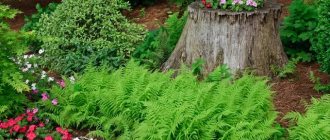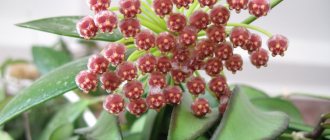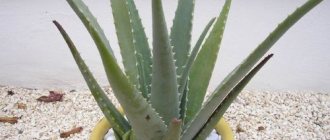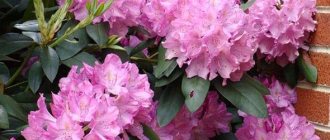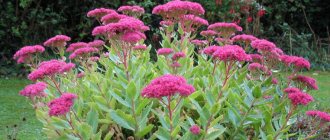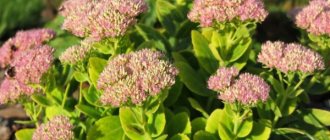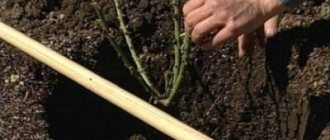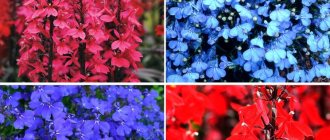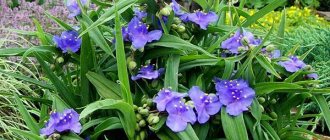Garden ivy or hedera is a perennial climbing vine. Valued for its unpretentiousness, fast growth and decorative leaves of different sizes and colors.
The leaves are green, variegated in color with red stripes, yellow splashes, and a white border. The shoots reach a length of more than 3 meters. The flowers are greenish-yellow in color, collected in inflorescences - umbrellas. Flowers attract the attention of insects, including bees. Flowering is not of interest, but the fruits in the form of berries give the ivy even more decorative. There are 15 species in the genus, but only a few species are common in culture.
Description
Garden ivy (Hedera helix) is a climbing vine-like perennial evergreen plant of the Araliaceae family. The Latin name comes from the Greek word "oedon" - singer. There is another version of the origin of the name from the Celtic word “hedea” - cord. The specific name comes from the word “helisso” - to curl.
This plant is widespread in South-West Asia, Southern, Western and Central Europe. On the territory of our country, garden ivy grows in the Caucasus and the territory of the Krasnodar Territory, in the Crimea. The natural habitat of ivy is beech and oak forests; it can also be found in lowlands and foothills.
Garden ivy is a heat-loving plant, but there are also frost-resistant varieties.
Most types of ivy have leaves that are leathery, shiny, and have a smooth surface penetrated by numerous veins. Depending on the type, the leaf plates can be three-toed, five-toed, or heart-shaped.
The color of the leaves is usually a solid green. However, there are species with variegated leaf blades: with yellow splashes, red stripes and white edging around the edges.
The plant is capable of growing over various surfaces due to numerous sucker-like aerial roots, which can cling not only to trees and their branches, but also to rough stone walls.
The length of ivy shoots can reach three meters in length. During the flowering period, the plant produces small greenish-yellow flowers, collected in umbrellas, which are of no decorative value. Flowers are very attractive to various insects, including bees.
After pollination, small berries of a dark, almost black color are formed on the ivy, which become a real decoration of the plant.
Please note that ivy is a poisonous plant, and the poison is contained in all its parts and, if it comes into contact with the skin, can cause itching, redness and even burns. However, not all people are susceptible to poison ivy. In any case, when working with this plant, it is recommended to use gloves to protect your hands.
Kinds
The plant has 16 species. They differ in the shape of the leaves and their color, flowering time, and temperature conditions of growth. In our country, gardeners grow only a few frost-resistant species.
Common ivy (Hedera helix)
This species is most widespread in our country because it is frost-resistant. Common ivy has a slow growth rate and can be grown not only as a garden plant, but also as a house plant. Loves a windless, shaded place and is easy to care for.
It has flexible vines that grow up to one meter in length, with alternately arranged glossy leaves. Each leaf blade is divided into three lobes and covered with bright veins.
Features of cultivation
Selecting soil and planting location
Garden ivy is an unpretentious plant that grows on almost any soil, except clay, which delays the supply of oxygen to the root system. Moreover, clay can retain moisture, which can lead to rotting of the ivy roots.
The best option for growing would be soil with lime and humus, that is, a moisture-intensive and breathable substrate.
Variegated varieties of garden ivy are planted on the sunny side, choosing a place in such a way as to prevent direct sunlight. For plants with dark green foliage, choose a shady place. There should be a support for the vine near the planting.
Temperature, humidity, watering
The development of the plant in the first two years after planting occurs rather slowly. In this regard, it is recommended to plant ivy in open ground in the spring, so that in the warm season the plant has time to become as strong and established as possible, and its root system has grown.
Garden ivy tolerates changes in ambient temperature normally. However, for cultivation in regions of our country where winters are often cold, it is imperative to choose frost-resistant species.
Being in dry air can cause the leaves to dry out and die. In this regard, regular spraying of the leaves may be required.
Since garden ivy is a moisture-loving plant, you should ensure that the substrate in which it grows is always moist. Moreover, ivy loves to be sprayed, so it is preferably watered using the sprinkling method. In summer, water often enough, at least 1-2 times a week, making sure that the earthen ball does not dry out; in winter, watering the plant should be reduced.
Loosening
Garden ivy needs regular loosening of the soil. If the soil has dried out due to insufficient watering, it is watered abundantly and loosened. Loosening is also carried out to prevent earth crusts from appearing after rain. The loosening process also helps to increase the breathability of the soil layer. However, this should be done carefully so as not to damage the roots.
Fertilizer and feeding
To speed up plant growth in the spring and summer, it is recommended to fertilize garden ivy once every two weeks. For feeding, you should use fertilizers for ornamental plants that contain nitrogen. In order for the plant to better survive the winter, starting from mid-summer, you can feed it with fertilizers containing potassium and phosphorus.
You can also fertilize ivy using manure mixed with water.
Transfer
Garden ivy does not tolerate transplantation well. Gardeners should carefully choose a planting site, remembering that the plant may die as a result of replanting.
How to plant ivy?
It is best to plant cuttings or parts of rhizomes in the spring, so that the plant has time to ripen sufficiently during the warm season and then overwinter more confidently. It is necessary to plant in a moisture-absorbing, nutritious, breathable substrate of neutral acidity. The ivy root system is poorly developed, so dig a shallow hole, 15-20 cm deep.
Advice
If the soil in the area is heavy, it is advisable to dig a deeper hole for planting and lay drainage made of expanded clay, broken bricks or other material. You can feed it with humus.
Reproduction methods
When propagating garden ivy, gardeners do not have any serious problems. This plant propagates easily; a large number of seedlings can be quickly grown from one bush.
Flower growers prefer the vegetative propagation method. This allows you to preserve species characteristics, which is rarely achieved when growing ivy from seeds.
When using vegetative propagation methods, you must follow the following rules:
- annual or biennial shoots are used for propagation;
- it is necessary to choose strong shoots with aerial roots;
- carry out the reproduction process in late spring or early summer;
- It is recommended to plant young plants in a new place in early autumn or spring. The latter is more preferable, as the plant will have more time to adapt and prepare for winter.
Growing conditions and use
Garden ivy has an unsurpassed ability to adapt and will grow well where there are conditions for development similar to the conditions of its natural growth. It will feel good in a shaded, damp place, but does not like stagnant moisture. It does not require fertilizing, but it is advisable to loosen the soil after rain to avoid crust formation.
Ivy is used as a self-healing green hedge, as well as for decorating building facades. It provides an attractive appearance, as well as insulating properties and protection from precipitation. It slightly dries out the soil around the foundation, which prevents the walls from becoming damp.
However, the unpretentiousness of ivy is a double-edged sword. Ivy is capable of climbing young trees with such density that they can fall from its weight. Fibrous adventitious roots spoil the plaster, shoots crawl into gutters and under the roof, pick up tiles, and serve as food for rodents and other parasites.
Advice
The decision to plant ivy should be made consciously, it is worth weighing all the pros and cons. To achieve positive effects, some care and skillful handling of the plant will be required.
By layering
Like other vines, garden ivy can be propagated by layering. This method is used most often when ivy is grown as a ground cover plant: branches lying on the soil are able to take root without outside help, but by stimulating this process, gardeners get new plants faster.
To carry out this method of propagation, the shoot should be laid on the ground and attached to the soil with special staples, and then sprinkled with nutritious soil. Small cuts are made on the bottom of the branches, which helps speed up the rooting process. It is necessary to water the cuttings regularly, maintaining stable soil moisture. After the vine has strengthened, you need to wait until spring or autumn and transplant the already strong ivy to the desired location.
Cuttings
Most often, garden ivy is propagated in this way, since it is quite simple and fast. The roots of the cuttings appear in just a few weeks. Cuttings can be taken at any time of the year, but it is better to use young shoots. For propagation, both apical and stem cuttings are used. The length of the apical cuttings should be from 9 to 21 cm, the lower two pairs of leaves should be removed. The cuttings must have an aerial root. If propagation is carried out by stem cuttings, then a young whole shoot with 8-10 leaves is used.
You can grow cuttings in water or a special solution that stimulates the development of the root system. It is allowed to use a mixture of peat and sand.
Any temperature above +15 degrees is suitable for rooting cuttings.
After rooting, the young plant should be grown in a container, and young ivy can be transplanted to a permanent place in the spring with the arrival of warmer weather.
Caring for young ivy
To achieve maximum decorativeness with ivy, you will have to be patient. This plant does not begin to grow vigorously right away, and will have to wait several years before the decorative task assigned to the vine is completed. But with proper care and optimal conditions, the waiting period can be shortened.
Conditions for ivy need to be selected carefully. They are hardy and adapt well. But if the task is to quickly garden, then you should choose places protected from drafts and wind. Air-permeable, fertile, deeply worked soil containing organic matter and moisture-absorbing soil is one of the conditions for the rapid growth of ivy.
In order for ivy to quickly reach the desired size, you first need to take care of stable soil moisture. Regular watering during drought and spraying leaves during particularly hot periods will help young plants not to suffer from extreme summer conditions and quickly grow both roots and vegetative mass. During the season, the soil is carefully loosened, preventing it from crusting, but without touching the roots and shoots of ivy. Protective cover in the first winter in the form of a simple layer of mulch will reduce problems during thaws and temperature changes. Ivy plants will not refuse a permanent mulch layer, which will protect the root system from overheating and stabilize the conditions for their development.
Seeds
This is the most difficult method of propagating garden ivy. The seeds are removed from the berries after ripening and dried for one to two days. Plant the seeds in prepared containers with a nutrient substrate, in which drainage holes are made, then water generously from a sprayer. After this, the containers are covered with glass, which is best not to be opened in order to maintain the greenhouse effect. Watering is carried out from a tray on which the containers stand. The first shoots should appear in 15-25 days.
Benefits of a green ivy fence
Garden ivy, as an option for hedges, has a number of advantages:
Possible problems
Despite the fact that ivy is a fairly unpretentious plant, some problems may arise when growing it.
If the leaves on evergreen garden ivy begin to turn yellow, the plant does not have enough water, and if the leaves begin to fall off, it means that the ambient air is very dry. Problems are solved by watering and spraying foliage.
If the plant does not have enough light, the variegated and bright green leaves will become faded. This problem can only be solved by transplanting the ivy to a more illuminated place.
Diseases and pests
Evergreen garden ivy is resistant to disease, however, when grown in too wet soil, the ivy may become infected with a fungus (rust, root rot). In this case, it is enough to remove damaged shoots with leaves covered with dark spots, treat the plant with a fungicide and reduce the intensity of watering.
Garden ivy is attacked by parasites such as spider mites, scale insects and aphids. If parasites are detected, it is necessary to immediately remove the damaged shoots and spray the ivy and plants planted in close proximity to it with the Actellik insecticide. If it was not possible to get rid of the insects the first time, the chemical treatment should be repeated after a week.
Possible problems in growing garden evergreen ivy in open ground
When growing a plant, the greatest dangers are thrips, whiteflies, aphids, mites and insects that are carried by the wind. When pests appear on leaves or stems, you must immediately begin treating perennial outdoor ivy with insecticides. The liana should be sprayed with karbofos or actellik diluted in water. Sometimes several irrigations are required to completely eliminate parasites.
Hedera helix mix or common ivy - home care
The affected areas must be removed so that the infection does not spread to the stems and leaves that are nearby.
Violation of care rules
There are several signs by which you can find out about the presence of pests or diseases:
- yellow and dry leaves indicate excess fertilizer and humidity;
- the pallor of the plant indicates a lack of ultraviolet rays, so it should be transplanted from the shade to an area with good lighting;
- yellow foliage signals dry soil, so you need to control watering;
- Dry air causes leaves to fall off; spraying with water from a hose will eliminate the problem.
Important! When parasites appear on a vine, it is necessary to inspect all nearby crops.
